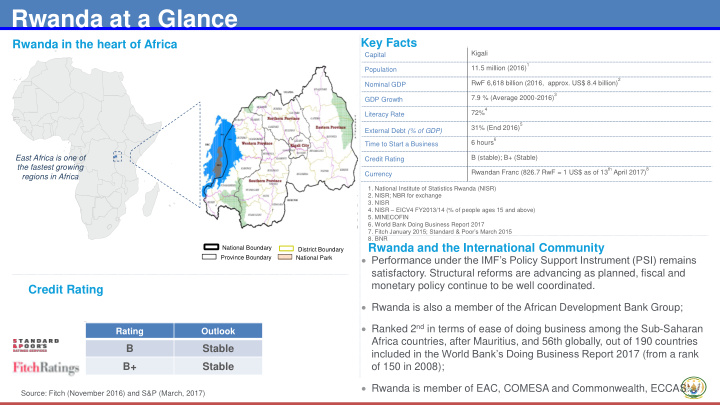



Rwanda at a Glance Key Facts Rwanda in the heart of Africa Kigali Capital 1 11.5 million (2016) Population 2 RwF 6,618 billion (2016, approx. US$ 8.4 billion) Nominal GDP 3 7.9 % (Average 2000-2016) GDP Growth 4 72% Literacy Rate 5 31% (End 2016) External Debt (% of GDP) 6 6 hours Time to Start a Business East Africa is one of B (stable); B+ (Stable) Credit Rating the fastest growing th April 2017) 8 Rwandan Franc (826.7 RwF = 1 US$ as of 13 Currency regions in Africa 1. National Institute of Statistics Rwanda (NISR) 2. NISR; NBR for exchange 3. NISR 4. NISR – EICV4 FY2013/14 (% of people ages 15 and above) 5. MINECOFIN 6. World Bank Doing Business Report 2017 7. Fitch January 2015; Standard & Poor’s March 2015 8. BNR Rwanda and the International Community National Boundary District Boundary Performance under the IMF’s Policy Support Instrument (PSI) remains Province Boundary National Park satisfactory. Structural reforms are advancing as planned, fiscal and monetary policy continue to be well coordinated. Credit Rating Rwanda is also a member of the African Development Bank Group; Ranked 2 nd in terms of ease of doing business among the Sub-Saharan Rating Outlook Africa countries, after Mauritius, and 56th globally, out of 190 countries B Stable included in the World Bank’s Doing Business Report 2017 (from a rank B+ Stable of 150 in 2008); Rwanda is member of EAC, COMESA and Commonwealth, ECCAS.. Source: Fitch (November 2016) and S&P (March, 2017)
RWANDA: Key Achievements over the last two decades Rapid growth built on prudent fiscal and monetary policies and structural reforms Macroeconomic stability, rapid economic growth and reduction in poverty Low level of Political stability, rule government debt of law and zero tolerance for corruption Comprehensive program of Market-friendly Economy investment in policy resilient to energy, environment external shocks agriculture, ICT, tourism
Compact with RWANDA: Investment opportunities G20 Compact with Africa 1. Reducing risk and cost of Financing for Private Investors (including for Infrastructure projects) 2. Further investment in reducing cost of doing business through investment in infrastructure for connectivity (air transport, rail transport, etc) and energy (generation and transmission) 3. Infrastructure for businesses through Industrial Parks (land, utilities, Advanced Factory Units) Contact information: Bilateral 1. Leonard Rugwabiza: leonard.rugwabiza@minecofin.gov.rw; Tel: +250 788 860 010 2. Ronald Nkusi: ronald.nkusi@minecofin.gov.rw; Tel: +250 788 309 561 Private Investor 1. Emmanuel Hategeka: emmanuel.hategeka@rdb.rw; Tel: +250 788 312 222 2. Winifred Ngangure: winifred.ngangure@rdb.rw
Compact with RWANDA Modules G20 Compact with Africa Expected support: Key reforms: Macroeconomic framework Macroeconomic framework • Technical assistance • Macroeconomic stability maintained with low- • Reforms to allow reduce cost of financing for level of debt (PSI program with IMF and continue strengthening public debt management) infrastructure projects in particular • Enhance tax compliance and broadening tax Business climate framework base (VAT and reaching out to untaxed sectors: • De-risking instruments for private investors agriculture, property tax) • Support in attracting private investors from G20 Business climate framework countries to Rwanda – disseminate information on • Infrastructure for Businesses through industrial conducive business environment/ reforms in parks (land+ utilities + connectivity to market) Rwanda Financing framework Financing framework • Development of domestic capital market and • Technical assistance in developing domestic financial and business services center capital market and financial services center • (de-risking, risk-sharing) Financing schemes to • Support De-risking and risk-sharing schemes for attract and facilitate private investment private investment
Recommend
More recommend